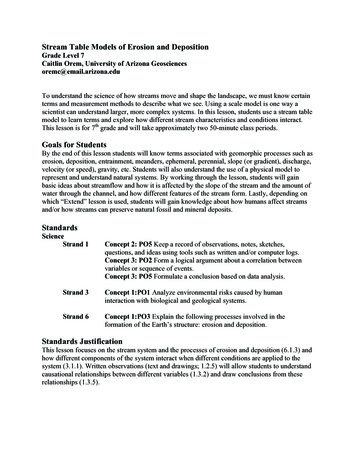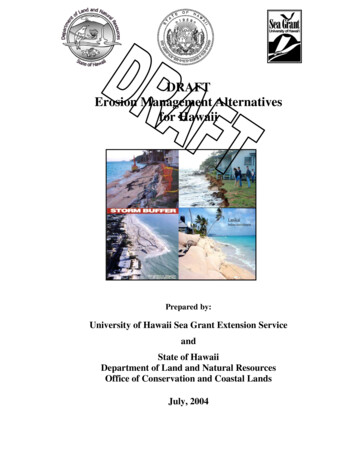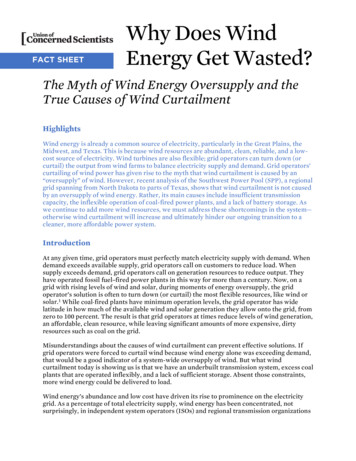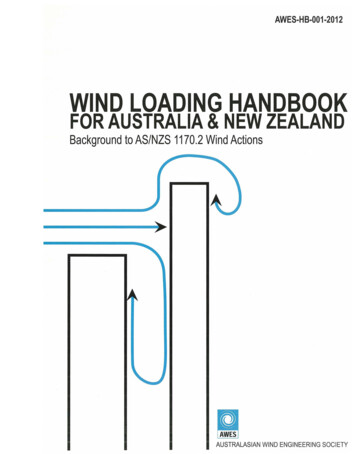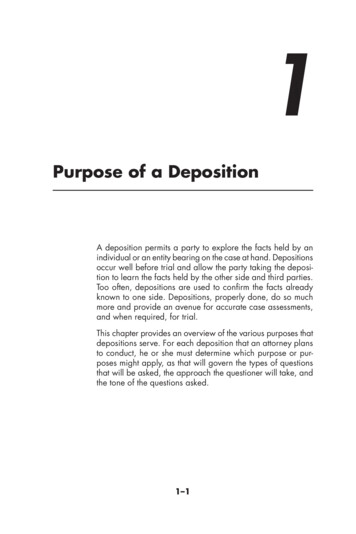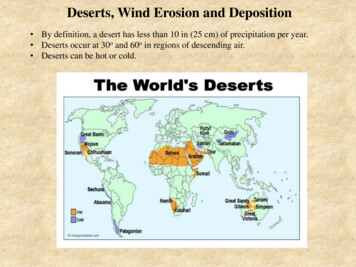
Transcription
Deserts, Wind Erosion and Deposition By definition, a desert has less than 10 in (25 cm) of precipitation per year. Deserts occur at 30o and 60o in regions of descending air. Deserts can be hot or cold.
Types of Deserts: Subtropical Deserts - general atmospheric circulation brings dry, subtropicalair into mid-latitudes. Examples: Sahara of Northern Africa, Kalhari ofSouthern Africa, and the Great Australian Desert. Continental Deserts - areas in the continental interiors, far from source ofmoisture with hot summers and cold winters. Examples: Gobi, Takla Makan Rainshadow Deserts - areas where mountainous regions cause air to rise andcondense, dropping its moisture as it passes over the mountains. Examples:Deserts east of the Sierra Nevada Mountains, California & Nevada, East of theCascades of Oregon and Washington, and East of the Andes Mountains inSouth America. Coastal Deserts - Areas where cold upwelling seawater cools the air anddecreases its ability to hold moisture. Examples : Atacama Desert of coastalPeru, Namib Desert of coastal South Africa. Polar Deserts - Cold polar regions where cold dry air prevails and moistureavailable remains frozen throughout the entire year. Examples: NorthernGreenland, and ice-free areas of Antarctica.
Erosion Even in deserts, themain agent of erosion iswater. Wind is a secondaryagent of erosion. Finesand grains are removedleaving behind coarsermaterial. The process iscalled deflation and thematerial left behindforms a desertpavement.
Wind erosion can also occur byabrasion. Ventifacts are any bedrocksurface or stone that has beenabraded or shaped by wind-blownsediment in a process similar to sandblasting.
Sediment transport Suspension Saltation Rolling along surfaceSuspensionSaltation
Deposition: Wind deposits form when a topographic barrier causes a drop in wind velocity on thedownwind side of the barrier. Topographic barriers can be such things as rocks, vegetation, and human madestructures that protrude above the land surface.
Dune sand versus stream sand: Dune sand is finer grained than stream sandbecause of the much lower density and viscosityof air. Smaller range in grain size (well sorted). Windcan only move a narrow range of particle sizes. Dune sand is well rounded. Stream sand is moreangularStream sand
Sand dunes form when there is(1) a ready supply of sand(2) a steady wind(3) an obstacle such as vegetation, rocks, or fences, to trap some of the sand.Dunes migrate by erosion of sand by the wind on the gentle upwind slope anddeposition and sliding on the slip face.
Barchan Dunes - crescent-shaped dunes with the points of the crescentspointing in the downwind direction, and a curved slip face on the downwindside of the dune. They form in areas where there is a hard ground surface, amoderate supply of sand, and a constant wind direction.
Transverse Dunes - large fields of dunes that resemble sand ripples on alarge scale. They consist of ridges of sand with a steep face in the downwindside, and form in areas where there is abundant supply of sand and aconstant wind direction.
Linear Dunes - long straight dunes that form in areas with a limited sand supplyand converging wind directions.
Parabolic (also called blowout) Dunes - "U" shaped dunes with an open endfacing upwind. They are usually stabilized by vegetation, and occur wherethere is abundant vegetation, a constant wind direction, and an abundant sandsupply. They are common in coastal areas.
Star Dunes - are dunes with several arms and variable slip face directionsthat form in areas where there is abundant sand and variable wind directions.
Loess - large deposit of wind deposited dust. Much of the loess wasderived from debris left by glacial erosion. Yellow river and loessdeposits, China.
Alluvial Fans and Bajadas - An alluvial fan forms where a mountain stream enters abroad flat valley and deposits sediment as its velocity decreases on entering the flattervalley. When a linear mountain range has several closely spaced valleys, the alluvial fansmay coalesce to form a gentle undulated slope on the sides of the bounding lowlands.Such coalesced alluvial fans are known as Bajadas.
Playa Lakes - standing bodies of water are rare in desert regions because rainfalland input from streams occurs only intermittently. Lakes that do form during therare periods of rainfall, quickly evaporate, leaving a dry lake bed behind. PlayaLakes (also called dry lakes) are formed in basins of internal drainage. The lakebeds often consist of salts (evaporites) that were carried in by streams andprecipitated during evaporation. These precipitated salts give the dry lake bed awhite color resembling a beach (playa means beach in Spanish).
Inselbergs - steep sided hills that rise above a surrounding relatively flat plain. Theyappear to form because the rock making up the inselberg is more resistant to erosionthan the rocks that once made up the surrounding plain. Inselbergs are common indesert regions, although they can also occur in other areas where differential erosiontakes place.Two of the most famous Inselbergs on Earth: Shiprock (l) and Uluru (r)
Desertification occurs as a result of climatic changes, such as changingpositions of the continents, or changes in ocean and air circulation patterns.Human impacts, such as overgrazing, draining of land, and lowering of thegroundwater table, can also contribute to desertification. As vegetation dies out,the soil is more easily eroded and may be lost so that other vegetation becomesdestabilized. Since soil can hold moisture, if the soil erodes, the area maybecome arid, and the desert expands.
Shifting Sands - Tanzania
Slip faceBasalt sand
Current ripples
Barchan DuneNet wind direction
Dune sand versus stream sand: Dune sand is finer grained than stream sand because of the much lower density and viscosity of air. Smaller range in grain size (well sorted). Wind can only move a narrow range of particle sizes. Dune sand is well rounded. Stream sand is more angular
